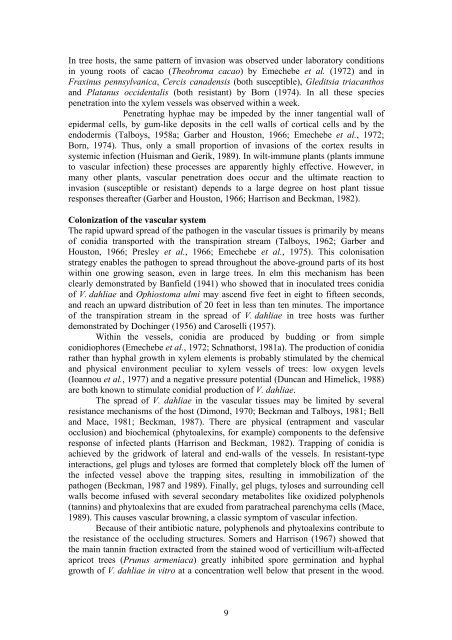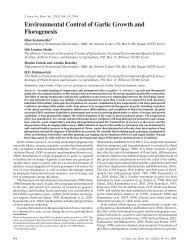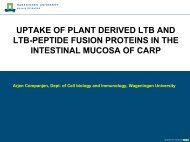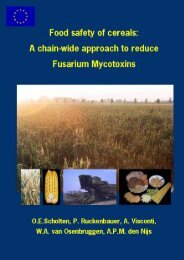2. Some general features of Verticillium wilts in trees
2. Some general features of Verticillium wilts in trees
2. Some general features of Verticillium wilts in trees
Create successful ePaper yourself
Turn your PDF publications into a flip-book with our unique Google optimized e-Paper software.
In tree hosts, the same pattern <strong>of</strong> <strong>in</strong>vasion was observed under laboratory conditions<strong>in</strong> young roots <strong>of</strong> cacao (Theobroma cacao) by Emechebe et al. (1972) and <strong>in</strong>Frax<strong>in</strong>us pennsylvanica, Cercis canadensis (both susceptible), Gleditsia triacanthosand Platanus occidentalis (both resistant) by Born (1974). In all these speciespenetration <strong>in</strong>to the xylem vessels was observed with<strong>in</strong> a week.Penetrat<strong>in</strong>g hyphae may be impeded by the <strong>in</strong>ner tangential wall <strong>of</strong>epidermal cells, by gum-like deposits <strong>in</strong> the cell walls <strong>of</strong> cortical cells and by theendodermis (Talboys, 1958a; Garber and Houston, 1966; Emechebe et al., 1972;Born, 1974). Thus, only a small proportion <strong>of</strong> <strong>in</strong>vasions <strong>of</strong> the cortex results <strong>in</strong>systemic <strong>in</strong>fection (Huisman and Gerik, 1989). In wilt-immune plants (plants immuneto vascular <strong>in</strong>fection) these processes are apparently highly effective. However, <strong>in</strong>many other plants, vascular penetration does occur and the ultimate reaction to<strong>in</strong>vasion (susceptible or resistant) depends to a large degree on host plant tissueresponses thereafter (Garber and Houston, 1966; Harrison and Beckman, 1982).Colonization <strong>of</strong> the vascular systemThe rapid upward spread <strong>of</strong> the pathogen <strong>in</strong> the vascular tissues is primarily by means<strong>of</strong> conidia transported with the transpiration stream (Talboys, 1962; Garber andHouston, 1966; Presley et al., 1966; Emechebe et al., 1975). This colonisationstrategy enables the pathogen to spread throughout the above-ground parts <strong>of</strong> its hostwith<strong>in</strong> one grow<strong>in</strong>g season, even <strong>in</strong> large <strong>trees</strong>. In elm this mechanism has beenclearly demonstrated by Banfield (1941) who showed that <strong>in</strong> <strong>in</strong>oculated <strong>trees</strong> conidia<strong>of</strong> V. dahliae and Ophiostoma ulmi may ascend five feet <strong>in</strong> eight to fifteen seconds,and reach an upward distribution <strong>of</strong> 20 feet <strong>in</strong> less than ten m<strong>in</strong>utes. The importance<strong>of</strong> the transpiration stream <strong>in</strong> the spread <strong>of</strong> V. dahliae <strong>in</strong> tree hosts was furtherdemonstrated by Doch<strong>in</strong>ger (1956) and Caroselli (1957).With<strong>in</strong> the vessels, conidia are produced by budd<strong>in</strong>g or from simpleconidiophores (Emechebe et al., 1972; Schnathorst, 1981a). The production <strong>of</strong> conidiarather than hyphal growth <strong>in</strong> xylem elements is probably stimulated by the chemicaland physical environment peculiar to xylem vessels <strong>of</strong> <strong>trees</strong>: low oxygen levels(Ioannou et al., 1977) and a negative pressure potential (Duncan and Himelick, 1988)are both known to stimulate conidial production <strong>of</strong> V. dahliae.The spread <strong>of</strong> V. dahliae <strong>in</strong> the vascular tissues may be limited by severalresistance mechanisms <strong>of</strong> the host (Dimond, 1970; Beckman and Talboys, 1981; Belland Mace, 1981; Beckman, 1987). There are physical (entrapment and vascularocclusion) and biochemical (phytoalex<strong>in</strong>s, for example) components to the defensiveresponse <strong>of</strong> <strong>in</strong>fected plants (Harrison and Beckman, 1982). Trapp<strong>in</strong>g <strong>of</strong> conidia isachieved by the gridwork <strong>of</strong> lateral and end-walls <strong>of</strong> the vessels. In resistant-type<strong>in</strong>teractions, gel plugs and tyloses are formed that completely block <strong>of</strong>f the lumen <strong>of</strong>the <strong>in</strong>fected vessel above the trapp<strong>in</strong>g sites, result<strong>in</strong>g <strong>in</strong> immobilization <strong>of</strong> thepathogen (Beckman, 1987 and 1989). F<strong>in</strong>ally, gel plugs, tyloses and surround<strong>in</strong>g cellwalls become <strong>in</strong>fused with several secondary metabolites like oxidized polyphenols(tann<strong>in</strong>s) and phytoalex<strong>in</strong>s that are exuded from paratracheal parenchyma cells (Mace,1989). This causes vascular brown<strong>in</strong>g, a classic symptom <strong>of</strong> vascular <strong>in</strong>fection.Because <strong>of</strong> their antibiotic nature, polyphenols and phytoalex<strong>in</strong>s contribute tothe resistance <strong>of</strong> the occlud<strong>in</strong>g structures. <strong>Some</strong>rs and Harrison (1967) showed thatthe ma<strong>in</strong> tann<strong>in</strong> fraction extracted from the sta<strong>in</strong>ed wood <strong>of</strong> verticillium wilt-affectedapricot <strong>trees</strong> (Prunus armeniaca) greatly <strong>in</strong>hibited spore germ<strong>in</strong>ation and hyphalgrowth <strong>of</strong> V. dahliae <strong>in</strong> vitro at a concentration well below that present <strong>in</strong> the wood.9







